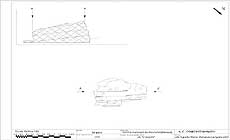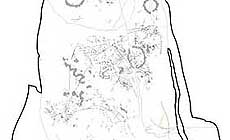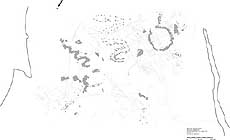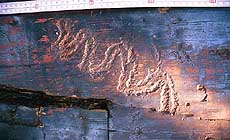 |
Description: |
Engravings
Paintings
Painted engravings
High or low-relief
Sculpture
The panel presents engravings made with different technical: percussion and incision. In chronological order first there is, on the center of Panel 2, a filiform figure which is partialy conserved but can be recognized as a deer representation. Global meassures are 49 cm long, from head to tail, and 41 cm high. It has a quite small head in proportion with the body and legs end in triangular shape. On the head big horns can be distinguished though badly damaged by rock oxidus. Very funny thing is the existence of a second back line arising from the same head and ending on a new backwards curvature, interpreted as the indication of another animal or movement of the first one, tough no legs can be associated clarly to tjhe second one. All along the surface there are several agroupations of filiforms, groups ol multitracing in the southern side, arround the deer and on the northern side, besides some long curves dispersed over, but for them not type can be given. Secondly, the group that's defined chronologically as later because of the percussion technique and for the clear superimpositions shows several types. First, there are Circles - simple, with appendix or composed by loose bows - three on the southern side, dispossed horizontally which meassure, from east to west, 10'5 cm. Diameter long, 7 cm. Diameter long and the third one 8 cm. Among the first circle and the second circle there is a punctuation and a bar lightly inclined toward the right; the bar measures 4 cm. long. The third circle is broken in half by a crack that is 1 cm. wide. The thickness of these circles is of 1 cm. Next, a circle, 10 cm. diameter long, with a vertical appendix (7 cm. long), cut in the middle by a crack, 1 cm wide that runs along the surface. Around the circle there is peckeds remains and incise lines that come under the pecked motif. To the left of this circle there are two snaky figures; the first figure is only drawn in its contour with a double paralel sinuous line, and it meassures 23 cm. Long, and it is clearly superimpossed to the paleolithic deer representation. The second figure, 17 cm. long, is surrounded of some peckeds remains ( little bars and loose bows). This area of the panel is travelled by more lines that cut to the figures made with percussion. Below, reading the panel to north, there is another figure that draws two peralel curves, carried out with the percussion technique. The northern part of the panel has two circles made with pecked and with loose bows, and the diameters measure 8 and 12 cm. of long; to the left, another group of loose bows, without definedshape.
|
Figures: |
total number 14
6 Circles, 3 snaky figures, 4 bars, 1naturalistic zoomorph , pecked remains, graphited lines, spots
|
|
 |
Chronology: |
Palaeolithic
Epipalaeolithic - Mesolithic
Neolithic
Copper Age
Bronze Age
Iron Age
Roman
Middle Age
Modern
Unknown
PALEOLITTHIC (Magdaleniense) 17.000-9.000 BP// EPIPALEOLITHIC (IX millenium b.C) // NEOLITHIC (IV-III millenia b. C.)// COPPER AGE ( II milenium b. C.)
|
Notes: |
In spite of the cracks the state of conservation of the engraving is good. EUROPREART DB Cheles records are just a little sample in short of the hole documentation of the site. All the documentation is registered in our own DB, and you can ask for more information at the e.mail adress barbaon@terra.com. |
|
 |
 NEW: Alpine rock paintings
NEW: Alpine rock paintings



